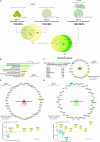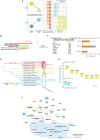In vivo Environment Swiftly Restricts Human Pancreatic Progenitors Toward Mono-Hormonal Identity via a HNF1A/HNF4A Mechanism
- PMID: 32161757
- PMCID: PMC7052484
- DOI: 10.3389/fcell.2020.00109
In vivo Environment Swiftly Restricts Human Pancreatic Progenitors Toward Mono-Hormonal Identity via a HNF1A/HNF4A Mechanism
Abstract
Generating insulin-producing β-cells from human induced pluripotent stem cells is a promising cell replacement therapy for improving or curing insulin-dependent diabetes. The transplantation of end-stages differentiating cells into living hosts was demonstrated to improve β-cell maturation. Nevertheless, the cellular and molecular mechanisms outlining the transplanted cells' response to the in vivo environment are still to be properly characterized. Here we use global proteomics and large-scale imaging techniques to demultiplex and filter the cellular processes and molecular signatures modulated by the immediate in vivo effect. We show that in vivo exposure swiftly confines in vitro generated human pancreatic progenitors to single hormone expression. The global proteome landscape of the transplanted cells was closer to native human islets, especially in regard to energy metabolism and redox balance. Moreover, our study indicates a possible link between these processes and certain epigenetic regulators involved in cell identity. Pathway analysis predicted HNF1A and HNF4A as key regulators controlling the in vivo islet-promoting response, with experimental evidence suggesting their involvement in confining islet cell fate following xeno-transplantation.
Keywords: cell fate; cell identity; differentiation; endocrine progenitors; pathway analyses; signaling.
Copyright © 2020 Legøy, Mathisen, Salim, Vethe, Bjørlykke, Abadpour, Paulo, Scholz, Ræder, Ghila and Chera.
Figures




Similar articles
-
Chronically Elevated Exogenous Glucose Elicits Antipodal Effects on the Proteome Signature of Differentiating Human iPSC-Derived Pancreatic Progenitors.Int J Mol Sci. 2021 Apr 2;22(7):3698. doi: 10.3390/ijms22073698. Int J Mol Sci. 2021. PMID: 33918250 Free PMC article.
-
Nanotopographical regulation of pancreatic islet-like cluster formation from human pluripotent stem cells using a gradient-pattern chip.Acta Biomater. 2019 Sep 1;95:337-347. doi: 10.1016/j.actbio.2018.12.011. Epub 2018 Dec 6. Acta Biomater. 2019. PMID: 30529081
-
In vitro generation of pancreatic β-cells for diabetes treatment. I. β-like cells derived from human pluripotent stem cells.Folia Histochem Cytobiol. 2019;57(1):1-14. doi: 10.5603/FHC.a2019.0001. Epub 2019 Mar 14. Folia Histochem Cytobiol. 2019. PMID: 30869153 Review.
-
Probing the missing mature β-cell proteomic landscape in differentiating patient iPSC-derived cells.Sci Rep. 2017 Jul 6;7(1):4780. doi: 10.1038/s41598-017-04979-w. Sci Rep. 2017. PMID: 28684784 Free PMC article.
-
Can pancreatic duct-derived progenitors be a source of islet regeneration?Biochem Biophys Res Commun. 2009 Jun 12;383(4):383-5. doi: 10.1016/j.bbrc.2009.03.114. Epub 2009 Mar 24. Biochem Biophys Res Commun. 2009. PMID: 19324022 Review.
Cited by
-
Glucose Concentration in Regulating Induced Pluripotent Stem Cells Differentiation Toward Insulin-Producing Cells.Transpl Int. 2024 Jan 18;37:11900. doi: 10.3389/ti.2024.11900. eCollection 2024. Transpl Int. 2024. PMID: 38304198 Free PMC article.
-
Targeted Gene Silencing by Using GapmeRs in Differentiating Human-Induced Pluripotent Stem Cells (hiPSC) Toward Pancreatic Progenitors.Methods Mol Biol. 2024;2736:23-38. doi: 10.1007/7651_2023_498. Methods Mol Biol. 2024. PMID: 37615889
-
A Method for Encapsulation and Transplantation into Diabetic Mice of Human Induced Pluripotent Stem Cells (hiPSC)-Derived Pancreatic Progenitors.Methods Mol Biol. 2022;2454:327-349. doi: 10.1007/7651_2021_356. Methods Mol Biol. 2022. PMID: 33786775
-
HNF4A and HNF1A exhibit tissue specific target gene regulation in pancreatic beta cells and hepatocytes.Nat Commun. 2024 Jun 22;15(1):4288. doi: 10.1038/s41467-024-48647-w. Nat Commun. 2024. PMID: 38909044 Free PMC article.
-
Engineering islets from stem cells for advanced therapies of diabetes.Nat Rev Drug Discov. 2021 Dec;20(12):920-940. doi: 10.1038/s41573-021-00262-w. Epub 2021 Aug 10. Nat Rev Drug Discov. 2021. PMID: 34376833 Review.
References
-
- Agulnick A. D., Ambruzs D. M., Moorman M. A., Bhoumik A., Cesario R. M., Payne J. K., et al. (2015). Insulin-producing endocrine cells differentiated in vitro from human embryonic stem cells function in Macroencapsulation devices In Vivo. Stem Cells Transl. Med. 4 1214–1222. 10.5966/sctm.2015-0079 - DOI - PMC - PubMed
Grants and funding
LinkOut - more resources
Full Text Sources
Research Materials

